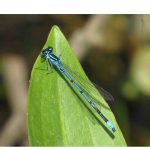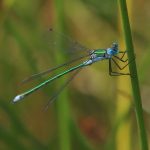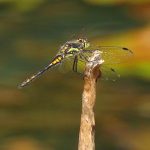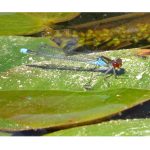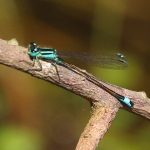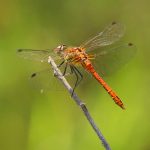County Dragonfly Recorder Mike Turton led a dragonfly walk at BBOWT’s Decoy Heath reserve on Saturday 7 July. It was a hot and sunny morning – too hot for some of the humans, but ideal for dragonflies. Emperor Dragonflies and Brown Hawkers patrolled across the first big pond, while a Four-spotted Chaser flew out across the open water, then returned to its perch. There were abundant Azure Damselflies in the poolside vegetation. Mike netted a specimen, to show the narrow blue stripes on the thorax. An Emerald Damselfly was perching with its wings held open sideways, rather than closed together, like most of the other damselflies. A Black Darter perched nearby. Out on the open water, Red-eyed and Small Red-eyed Damselflies rested on floating pondweed leaves. The Small Red-eyed Damselflies had a characteristic resting position with the tip of the abdomen raised. A pair of linked Common Darters were flying over the open water, with the female dipping her abdomen under the surface to lay her eggs. A male Slow-worm was found nearby. In open heathland on the way to the next pond, a Common Blue Damselfly was netted for closer inspection. It had broader blue stripes on the thorax than the Azure Damselflies which had been seen earlier. The second pond was rapidly drying out. A female White-legged Damselfly and a Blue-tailed Damselfly were found here. Amongst the vegetation were a number of exuviae of the Emperor Dragonfly, showing the hole at the top of the thorax through which the adult dragonfly had emerged. On the way back, a perched worn and rather slim Broad-bodied Chaser had the group puzzled for a while, until the faded yellow dots on the side of the abdomen were seen. The third pond had more open water, again with patrolling Emperor Dragonflies and Brown Hawkers. A Ruddy Darter and a Scarlet Darter perched nearby, allowing for comparisons between the two. The Ruddy Darter was a bright scarlet with a waisted abdomen and all-red thorax. The Common Darter was a duller orange-red with stripes at the side of the thorax and a straight abdomen. The return walk was over the grassy bank, looking for butterflies. There were many Meadow Browns, a few Marbled Whites, a single Common Blue and tiny Small or Essex Skippers which were too active for exact identification.
Pictures by Sue White and Fiona Brown

